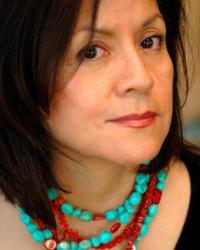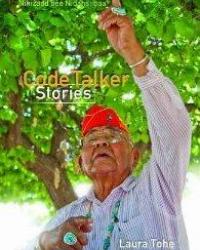On the Importance of Being Untranslatable
In February 2013, Professor Laura Tohe lectured on the topic of Navajo Code Talkers, in conjunction with the publication of her book, "Code Talker Stories" (Rio Nuevo Press 2012), and the exhibit, “Native Words, Native Warriors, and Navajo Code Talkers: Photographs by Kenji Kawano,” at The Heard Museum (January 1-March 30, 2013). Tohe’s father, Benson Tohe, was just sixteen years old when he enlisted in the Marines and was assigned to the Code Talker unit. Tohe did not know about his war years at all, until her father briefly mentioned his trip to Washington, DC in 1982, when the Navajo Code Talkers were publicly honored by President Ronald Reagan. The Code Talkers had been sworn to secrecy after they were discharged, and none of their families and descendants knew that their fathers and grandfathers had used the Navajo language to devise an unbreakable code.\r\n
Tohe began the book project to record and preserve a history in danger of being lost. Originally there were 432 Code Talkers, and today, there are fewer than thirty-five left, all of whom are now in their 80s and 90s. Tohe interviewed, and Debbie O’Grady photographed, twenty of the remaining Navajo Code Talkers. She described what she hoped to achieve with the book as follows: “I knew I wanted to publish a bilingual text that would be useful to those literate in the Navajo language and for those interested in seeing the written language. I also wanted to record in the Code Talkers\' own words the stories of their lives before, during, and after the war for the Navajo Nation and the public.”
Dramatically, the Navajo Code Talkers developed a code that remained unbroken at the end of WWII, that was in essence “untranslatable” outside those who developed the code, based on the Navajo language itself. “It\'s remarkable how the Code Talkers developed the code in a short period of time, something like two or three months,” Tohe exclaimed. “While the men I interviewed didn\'t develop the code, the first twenty-nine Code Talkers devised code words that were non-existent in the Navajo language, such as ‘grenade,’ ‘submarine,’ ‘torpedoes,’ and ‘observation plane.’ The Navajo language is descriptive and verb-based, so they described the military artillery by equating it with an animal or object, or they made new words. ‘Observation plane’ was named ‘owl,’ because both observe. My favorite is ‘potato’ for ‘grenade,’ because both can be held in the hand and thrown. ‘Iron fish’ became the word for ‘submarine.’ The words were culturally relevant only to the Code Talkers, which was another reason the Japanese cryptographers could not break the code.”
Knowing little of the code and the lives of the Code Talkers, Tohe was surprised by much of what they told her about the battles they survived and what they accomplished with the Navajo language. Because of assimilation policies in place at the schools on the Navajo reservation, they were told not to speak the Navajo language. When they enlisted in the Marines, however, they were told, shockingly, to use the Navajo language to devise a code! By the time Tohe finished the interviews, she had developed a profound respect for what the Code Talkers accomplished, as will all who read her important book, Code Talker Stories.
Photo of Laura Tohe by Julaire Scott. | Related: Laura Tohe comments on the Navajo translation of the sci-fi film Star Wars.
Flower word cloud image, “A Rose by Any Other Name," created on Tagxedo



